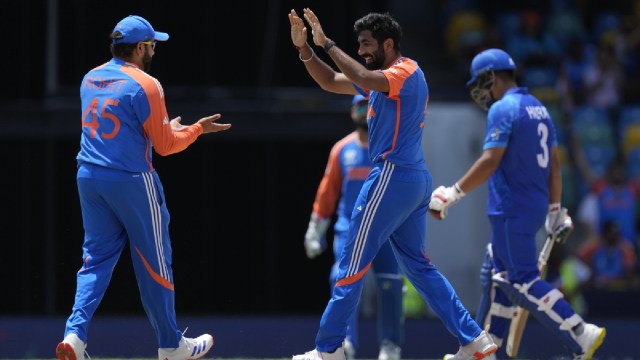
A cloud of resignation draped the Afghanistan dugout, as India’s bowlers feasted on them like hungry vultures. The defeat, by 47 runs, had an eerily familiar feel to it, a movie they had watched several times—Afghanistan displayed flashes of brilliance, ignited stray flames of an upset but in the end frozing against their old nemesis. India have won all eight of their previous encounters—the ninth was not to veer from the old script.
This was a grim reminder that Afghanistan has not shed some of the associate nation traits; they fail to seize moments, they over-rely on star individuals, like Rashid Khan, they don’t have a fallback plan when the tide is against them. They had India at 11/1, could have been 39/2 but for Naveen-ul-Haq letting a Rishabh Pant catch burst through his hands and hit his chest.
The rejuvenated Pant had just begun a counterattack that would tone-set the game. Runs-wise, the drop didn’t cost much. He departed next over. But the batsmen who followed him knew exactly how to navigate India to an infallible total. And Afghanistan’s bowlers didn’t know how exactly they could stop India’s batsmen from clutching the game with an iron grip.
Barring the immaculate Rashid, who snared Pant, Virat Kohli and Shivam Dube to keep his team in the game, all three with leg-breaks, the rest didn’t display the wits to stop a group of batsmen gaining an infallible edge with every game.
As the consequence of a clinical assault, Afghanistan’s fabled grit and gumption melted. When India’s batsmen, more skilled and experienced, threw punches, they staggered and fell flat on the face, cursing their wretched luck that Suryakumar chose them, and this day, to rediscover his most violent touch.
Throughout the time he batted—which was only 28 balls and 51 minutes, though it would seem longer and could stay longer in their mind—they seemed to be sleepwalking.
It’s the illusion Suryakumar’s batting could conjure. The audience twitch their eyes, pinch their skin to confirm it’s all real, and not a creation of their mind. It’s indeed real, just that Suryakumar is operating at an unreal plane, an elevated space when his mind imagines a shot lesser batsmen don’t see, the brain transmits the order to the limbs, and the limbs twist and contort in unusual shapes to grant his wish. It’s not playstation shot-making; it’s just the coincidence of a highly imaginative batsmen being a highly skilful one too. It’s even a step in T20s batting’s evolution, a batsman from the future, a batting alien in the human flesh.
His biggest gift is how he changes perceptions of the audience. The pitch, until the moment he began to unbox his tools, seemed slow and sluggish. When he batted, it suddenly acquired an altogether different set of characteristics. The ball was coming along nicely onto the bat, the outfield gathered pace, the ground began to look tiny and the stands seemed twice as crowded it really was.
This should really be a knock that should be remembered for his remarkable sweeping. Few possess a larger sweeping-range than him. When he is in the mood, in the space, it doesn’t matter how you bowl or where you bowl. Drifting into his body, he would swing it fine, pin on off-stump, he would flat-bat, often in front of the square, and if it’s wider, he would flay through midwicket, like he did Rashid Khan, Afghanistan finest bowler on the day.
The leg-spinner gave away just 26 runs, 16 off those stemming from Suryakumar’s bat. Of just six balls. Yadav’s body, like a twistable gymnast, takes unusual forms. He resembled someone about to mount on a horse, when he shifted his right leg square across his stumps, crouched to get under the ball and flapped Azmatullah Omarzai through square leg.
These are just party tricks. The real deals were the two straight-batted sixes, of Azmatullah and Fazalhaq Farooqi. The Afghanistan bowler exacted revenge soon after; but by that time, the contest seemed to have slipped through their hands. He found India at 54 for 2 in seven overs and left them at 150 for five in 17 overs.
As hearty news for India was Hardik Pandya’s touch. The most vital lower-middle order batsmen, his batting seemed to be on the wane in the last 15 months. But here was back to his destructive best, his 24-ball-32 an exhibition of crisp stroke-play. The two sixes he struck were throwback Pandya, all fluid bat-swing and shuddering power. The most spectacular, though, was a drive through cover point, against the turn, off Rashid.
His late blitz powered India to 181, a total that was always steep against an ever-evolving bowling firm. Jasprit Bumrah, an inspired force, performed the headline act with another three-wicket haul of fire and penetration (4-1-7-3!); Arshdeep donned the support cast with another three wicket-haul. But the dimension that would make India’s bowling cast deadlier is the form of the spinner. Kuldeep Yadav was the missing piece in the jigsaw, and he demonstrated why his addition lends cutting edge to the spin pack. It’s now Bangladesh’s turn next to watch the familiar movie.
Get latest updates on T20 World Cup along with live score updates for all matches.
© The Indian Express Pvt Ltd
First uploaded on: 21-06-2024 at 00:29 IST


